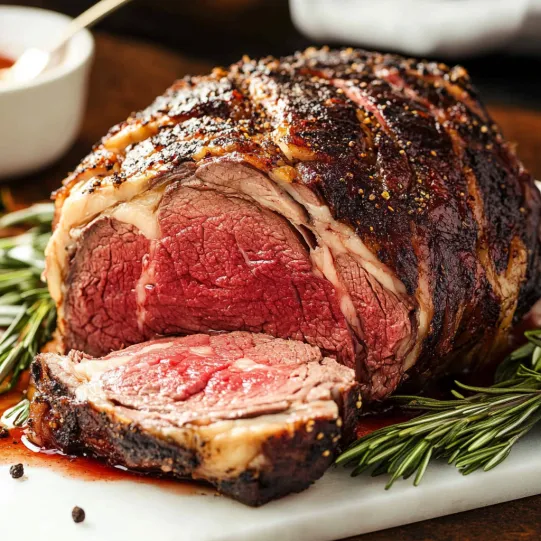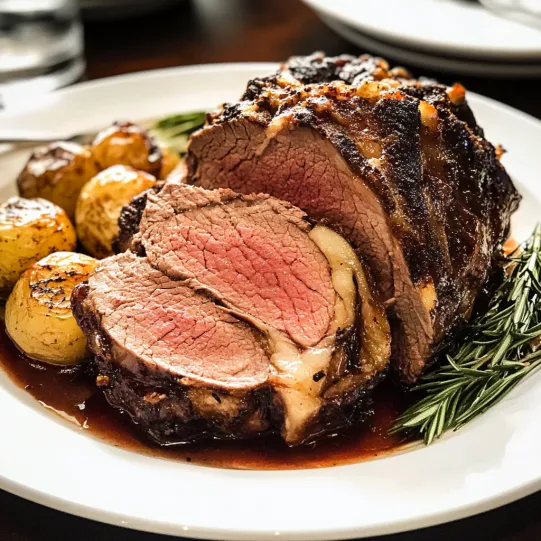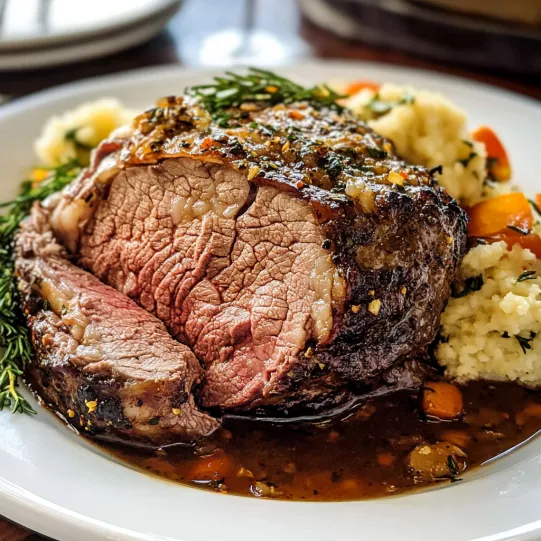 Save
Save
This prime rib roast has become my holiday masterpiece after years of perfecting the technique. The combination of a perfectly cooked medium-rare interior with a flavorful herb and spice butter crust creates an unforgettable centerpiece for special gatherings.
I first made this prime rib for Christmas dinner three years ago when I wanted something spectacular yet approachable. The look on my father in laws face when he took his first bite told me this would become our new holiday tradition.
Ingredients
- Butter: At room temperature essential for creating a spreadable compound butter that adheres to the roast
- Chili powder: Adds warmth without overwhelming heat choose a mild variety for balanced flavor
- Cumin: Brings earthy undertones that complement the natural richness of the beef
- Fresh thyme and rosemary: Provide classic aromatic notes that perfume the meat as it cooks
- Garlic: Minced fine intensifies as it roasts creating pockets of savory flavor throughout
- Prime rib: Ideally with good marbling for the most tender juicy result
- Onions: Quartered create a flavorful bed for the roast and later enhance the gravy
- Dry red wine: Adds depth and acidity to cut through the richness of the finished dish
Step-by-Step Instructions
- Bring meat to room temperature:
- Remove your prime rib from all packaging and let it sit at room temperature for 1-2 hours. This critical step ensures even cooking from edge to center. Pat the roast completely dry with paper towels to promote better browning.
- Prepare the oven:
- Heat your oven thoroughly to 450°F for at least 30 minutes. This initial high heat creates a beautiful crust on the exterior of your roast.
- Create compound butter:
- Mix softened butter with chili powder cumin fresh herbs garlic salt and pepper until thoroughly combined. The butter should be completely smooth with herbs and spices evenly distributed throughout.
- Coat the roast:
- Using your hands or a spatula apply the compound butter generously over the entire surface of the prime rib. Press it gently to adhere ensuring every inch is covered with this flavorful mixture.
- Prepare the roasting base:
- Arrange quartered onions garlic cloves and herb sprigs in your skillet or roasting pan creating a flavor platform that will later contribute to your gravy. Place the butter coated roast on top of this aromatic bed.
- Roast with precision:
- Begin cooking at 450°F for exactly 15 minutes to form a crust then reduce heat to 325°F. Continue roasting until an internal thermometer reads 120°F which will take approximately 15 minutes per pound. This temperature gradient ensures a perfect medium rare result.
- Rest properly:
- Transfer the cooked roast to a cutting board and tent loosely with foil. Allow it to rest undisturbed for 20 minutes. During this time the internal temperature will rise to 130°F and the juices will redistribute throughout the meat.
- Make the gravy:
- While the meat rests place the skillet with aromatics over medium high heat. Add wine and broth then bring to a boil before reducing to a simmer for 5 minutes. Thicken with cornstarch slurry then strain for a silky smooth finishing sauce.
 Save
Save
My favorite aspect of this recipe is the versatility of the compound butter. I've experimented with different spice combinations but always return to this version. The subtle heat from the chili powder against the herbaceous background creates a perfect complement to the rich beef.
Choosing the Perfect Roast
Select a prime rib with good marbling throughout as this fat renders during cooking creating unparalleled tenderness and flavor. For best results ask your butcher for a roast from the chuck end which contains more fat than the loin end. The ideal size for entertaining is a 5 pound roast which comfortably serves 8-10 people with potential leftovers. Remember that bone in roasts cook slightly differently than boneless but both work beautifully with this recipe.
Temperature Guide for Perfect Doneness
Understanding temperature is crucial for prime rib success. The recommended 120°F internal temperature before resting will rise to 130°F which delivers a perfect medium rare center. If you prefer a different doneness adjust accordingly using this guide rare 115°F before resting medium 130°F before resting medium well 140°F before resting. Remember that the ends will always be more done than the center making this roast perfect for accommodating different preferences among your guests.
Leftover Magic
Prime rib transforms beautifully into new meals the next day. Thinly sliced cold leftovers make incredible sandwiches on crusty bread with horseradish cream. Dice the meat to add luxury to a quick hash with potatoes and onions topped with a fried egg for breakfast. For an easy dinner chop leftover prime rib and add to a mushroom stroganoff or stir into pasta with the leftover gravy thinned slightly with cream. Store leftovers tightly wrapped in the refrigerator for up to 4 days or freeze for up to 3 months.
 Save
Save
Serving Suggestions
This prime rib deserves thoughtful accompaniments that complement without overwhelming. Classic pairings include creamy horseradish sauce Yorkshire puddings and crispy roasted potatoes. For vegetables consider roasted Brussels sprouts with bacon green beans almondine or a simple winter salad with bitter greens. Wine pairing is equally important select a bold Cabernet Sauvignon Malbec or aged Bordeaux that can stand up to the richness of the beef without overpowering the subtle herb flavors.
Common Recipe Questions
- → How do I know when my prime rib is perfectly cooked?
For perfect medium-rare prime rib, remove the roast from the oven when the internal temperature reaches 120°F (49°C). After resting for 20 minutes (covered with foil), the temperature will rise to approximately 130°F (54.5°C). Always use an instant-read digital meat thermometer inserted into the thickest part of the roast for accurate readings.
- → Why is it important to bring the prime rib to room temperature before cooking?
Bringing your prime rib to room temperature (letting it sit out for 1-2 hours before cooking) ensures even cooking throughout the roast. Cold meat straight from the refrigerator will cook unevenly, with the outside potentially overcooking before the center reaches the desired temperature.
- → Can I prepare the compound butter ahead of time?
Yes! The compound butter can be prepared up to 3 days in advance. Mix all ingredients together, form into a log on parchment paper, wrap tightly, and refrigerate. Remove from the refrigerator about 30-60 minutes before you need to spread it on the roast so it softens to a spreadable consistency.
- → What's the best way to carve a prime rib roast?
Allow the roast to rest properly first. Remove any strings if present. Place the roast on a cutting board with the bones facing down, then slice against the grain in even portions using a sharp carving knife. For boneless presentation, you can remove the entire rack of ribs before slicing, or slice between the bones for bone-in servings.
- → What can I serve alongside this prime rib?
Prime rib pairs beautifully with classic sides like mashed potatoes, roasted vegetables, Yorkshire pudding, creamed spinach, or a fresh green salad. The red wine gravy is particularly delicious drizzled over mashed potatoes. For beverages, consider serving a robust red wine like Cabernet Sauvignon or Merlot to complement the rich flavors.
- → How should I store and reheat leftover prime rib?
Store leftover prime rib in an airtight container in the refrigerator for up to 3-4 days. For best results when reheating, warm it slowly in an oven preheated to 250°F until just heated through (about 10-15 minutes), being careful not to overcook it. Alternatively, slice it thinly for sandwiches and enjoy it cold or at room temperature.
